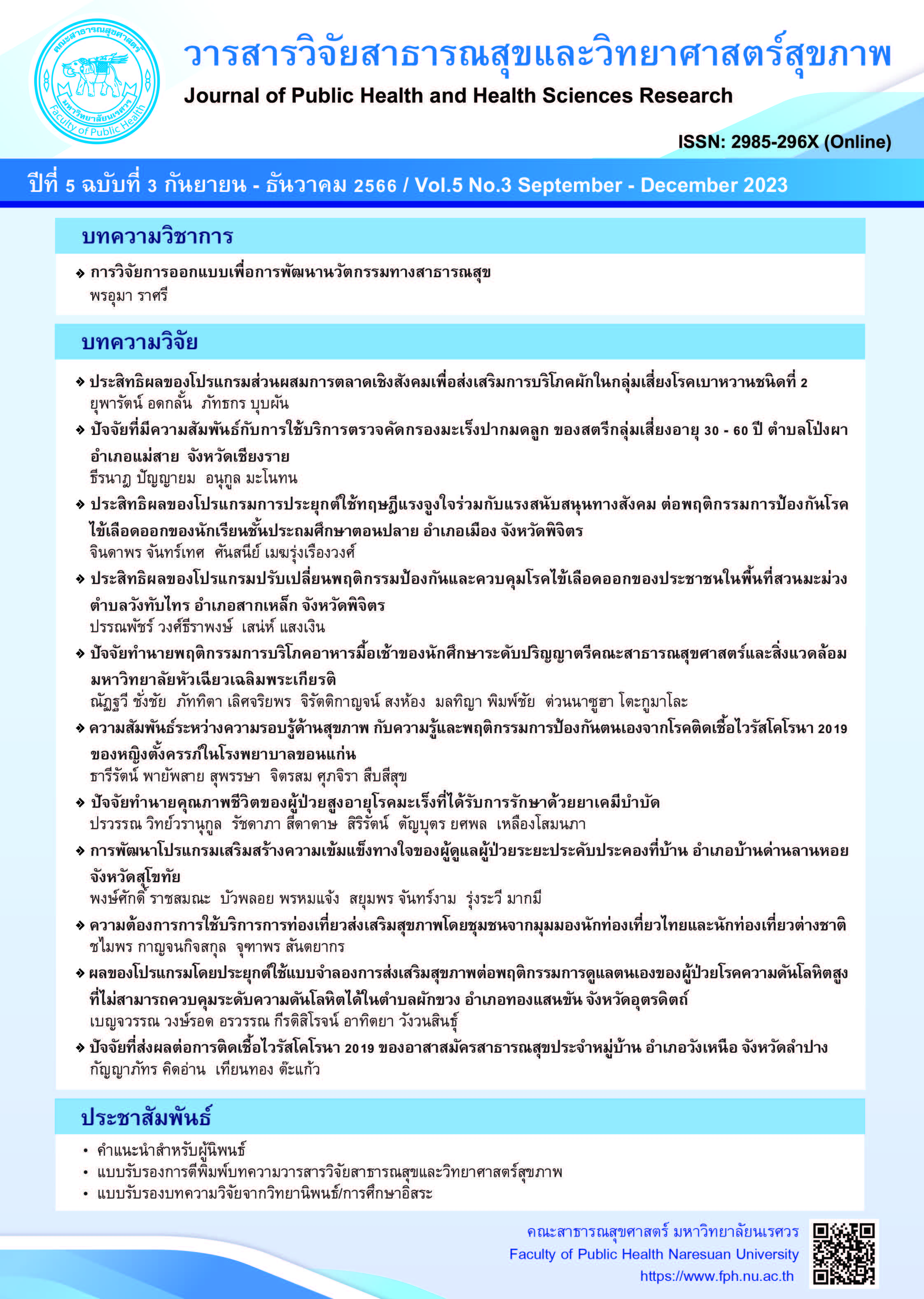Design research for development innovation in public health
Keywords:
Design research, Innovation, Public healthAbstract
In the era of progress in digital technology, both government agencies and private sectors have brought such technology to research and develop innovations to enhance the quality of life of the Thai population. Public health agencies strive to drive research and innovation by public health officials to improve the quality of public health services in the future. Therefore, public health officials are a group of personnel who play an important role in research and innovation in public health development, especially at the operational level. From past operations, it was found that public health workers had insufficient support knowledge of innovation development. The deficiency of integration with various partners, and creating works according to their own expertise rather than consultation with the needs of the country which resulted in the research results cannot be used in an actual context. However, the research design can close that knowledge gap because the research methodology can focus on the participation of users to produce innovative products that can respond to problems in specific contexts. It also produces a theoretical output, known as the new design principle, which is derived from improving the intervention with the aim of it can be used in an actual context. Therefore, this article focuses on presenting principles of research design, as well as the application of research design to develop innovations in
public health.
References
Bandura, A. (1997). Self-efficacy: The exercise of control. New York: Freeman.
Brown, A. L. (1992). Design experiments: Theoretical and methodological challenges in creating complex interventions in classroom settings. The journal of the learning sciences, 2(2), 141-178.
Chasanidou, D., Gasparini, A. A., & Lee, E. (2015). Design thinking methods and tools for innovation. Paper presented at the Design, User Experience, and Usability: Design Discourse: 4th International Conference, DUXU 2015, Held as Part of HCI International 2015, Los Angeles, CA, USA, August 2-7, 2015, Proceedings, Part I.
Chintapanyakul, T. (2019). Development of a program for enhancing research-practice nexus in clinical nursing using ict-based learning: Design research. Thesis of Doctoral of Philosophy in Educational Research Methodology, Chulalongkorn University, Bangkok. (in Thai)
Department of Health Service Support, Ministry of Public Health. (2020, August 1). The HSS’s 5 Year Digital Transformation Strategic Plan. Retrieved May 10, 2023, from https://hss.moph.go.th/image/plan1.pdf. (in Thai)
Department of Medical Sciences, Ministry of Public Health. (2022, September 23). Government performance summary report according to the performance agreement (PA) and measures to improve efficiency in government performance and the assessment of organizational executives. Retrieved May 10, 2023, from http://healthkpi.moph.go.th/kpi2/kpi/index/?id=1967. (in Thai)
Golderg, R., & Ruehlen, J. (n. d.). Fail fast and learn fast: IBM garage practices. IBM. Retrieved January 4, 2023, from https://www.ibm.com/garage/method/practices/culture/failing-fast/.
Goodyear, P. (2018). Design research. Health Education in Practice: Journal of Research for Professional Learning, 1(1), 7-17.
Health Systems Research Institute. (2022, August). Health systems research institute strategic plan 2022-2026. Retrieved May 10, 2023, from https://kb.hsri.or.th/dspace/handle/11228/5404. (in Thai)
Hasso Plattner Institution at Stanford. d.school. (n. d.). An introduction to design thinking: Precess guide. Retrieved January 10, 2023, from https://web.stanford.edu/~mshanks/MichaelShanks/files/509554.pdf.
Lucienne, T.M., Blessing & Amaresh Chakrabarti. (2009). DRM, a design research methodology.
Meyers, G. L., Jacobsen, M., & Henderson, E. (2018). Design-based research: Introducing an innovative research methodology to infection prevention and control. Canadian Journal of Infection Control, 33(3). Retrieved from https://ipac-canada.org/photos/custom/CJIC/CJIC_Fall2018_Meyers.pdf.
Office of the National Economic and Social Development Council on NESDC. (2019). National Strategy 2018-2037. RetrievedMay 10, 2023, from https://drive.google.com/file/d/1XSBMp8OCsauJqECOB-XZLB91-cRrNsEV/view. (in Thai)
Promdit, B. (2021). Factors Influencing Innovation Development Behavior on Disease Prevention and Control among Health Officers in Tambon Health Promoting Hospital, Chanthaburi Province. The Office of Disease Prevention and Control 10th Journal, 19(2), 31-42. (in Thai)
Sanders, E. B. N., & Stappers, P. J. (2014). Probes, toolkits and prototypes: Three approaches to making in codesigning. CoDesign, 10(1), 5-14.
Savic, S., & Huang, J. (2014). Research through design: What does it mean for a design artifact to be developed in the Scientific context? Paper presented at the Proceedings of the 5th STS Italia Conference: A Matter of Design. Making Society through Science and Technology.
Vaezi, H., Moonaghi, H. K., & Golbaf, R. (2019). Design-based research: Definition, characteristics, application and challenges Journal of Education in Black Sea Region, 5(1), 26-35.
Van den Akker, J. (1999). Principles and methods of development research. Design approaches tools in education training, 1-14.
Van dern Akker, J., Gravemeijer, K., McKenney, S, & Nieveen, N. (2006). Educational design research. New York, NY: Routledge.
Wongwanich, S. (2021). Design research in education. Bangkok: Chulalongkorn University Press. (in Thai)
Zimmerman, J., Stolterman, E., & Forlizzi, J. (2010). An analysis and critique of Research through Design: towards a formalization of a research approach. Paper presented at the proceedings of the 8th ACM conference on designing interactive systems.
Downloads
Published
How to Cite
Issue
Section
License
Copyright (c) 2023 Journal of Public Health and Health Sciences Research

This work is licensed under a Creative Commons Attribution-NonCommercial-NoDerivatives 4.0 International License.
The published article is copyrighted by the Journal of Public Health and Health Sciences Research.
The statements that appear in each article in this academic and research journal are the personal opinions of each author and are not related to Naresuan University and other faculty members in the university. Responsibilities regarding each article are the responsibility of each author.






